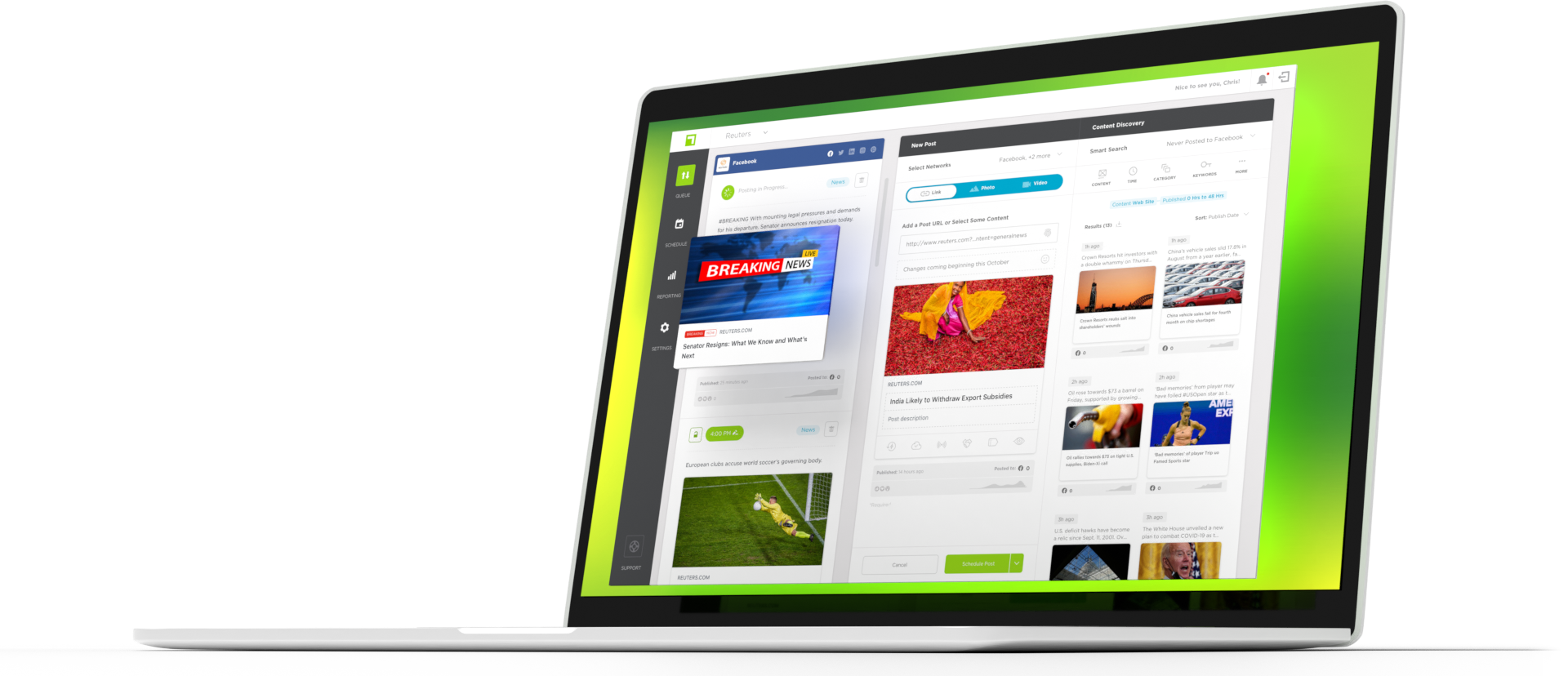An AI social publishing platform – publishing that is automated using artificial intelligence – may help you lighten the posting load while your team focuses on content creation, meaningful audience interactions, and other more involved tasks.
Social publishing, broadly, is the act of posting content in a way that allows your audience to interact with it on social media through comment sections, live streams, memes, and any other social content. Essentially, the days of a publisher being able to survive by just writing articles are long gone—you must engage with your users wherever they are.
What does this mean, and how do you start?
The idea is to find your audience and engage them in a meaningful way. Meaningful engagement can happen in any number of ways – newsletters, comment sections, and more. The most prevalent element of social publishing is going to be social media. Facebook, Twitter, Instagram, LinkedIn, and any other platform are ways to connect with your audience.
Start with the basics: Learning what each platform can offer and then understanding AI social publishing well enough to conquer everything with less human resources.
Here is a look at what each of the big platforms has to offer right now!
Facebook is the most widely used platform worldwide, which can be a plus and a minus – you have a huge potential audience and many people competing for that same space. A lot is going on here, but posting to Groups and Pages can be easy with an AI social publishing tool.
Within the platform, you have access to:
- Pages, profiles, and groups
- Text, image, link, and video Feed posts
- Stories
- Reels
- Live video
- Rooms
- Groups
- Messenger
- Marketplace
- Events
- Facebook Watch
- Business Manager to manage multiple pages, page access, and Instagram and Facebook ads.
The pros
Facebook is going to have the most robust options for paid marketing, posting, and reach. It’s the OG social network with the most extensive worldwide reach, and there are benefits to that.
The cons
Facebook tends to skew a bit older, which could either be a pro or a con depending on your goals. While the size and reach of the platform are a benefit, it can also be noisy and difficult to reach your target audience.
Instagram has become a vital branding tool. The aesthetic, image-heavy platform has become a critical part of the social landscape. As a Facebook property, the backend of the ad server is run through Business Manager, which makes running ads on both Facebook and Instagram quick and straightforward.
Within the platform, you have access to:
- Business and personal profiles
- Image and video posts
- Stories
- Reels
- Live video
- IGTV
- Shops
- Business Manager to manage multiple pages, page access, and Instagram and Facebook ads.
The pros
Instagram’s mission is a lot more defined. The image and video-centric platform limits some of the clutter and focuses the user on the feed. In addition, strict aspect ratios and length limitations give you an easy framework to work within.
The cons
If you’re trying to drive traffic, it can be a challenge. The lack of native link real estate makes it difficult. Your bio link is your only option until you reach 10k followers and can add a swipe-up link in your Stories.
LinkedIn is the platform many publishers sleep on, but maybe they shouldn’t. There is much opportunity to reach a specific audience. If you’re a news publisher, business, finance, or in an industry related to employment, this could be a solid opportunity for you.
Within the platform, you have access to:
- Business and personal pages
- Image, text, link, and video posts
- Stories
- Groups
- Messaging
- Job search/recruiting functionality
- Sponsored content placement
- LinkedIn Learning
- Newsletters
The pros
LinkedIn has a clear purpose, and that purpose is professional networking. It’s an excellent place for industry news (any industry, really), networking, and groups. LinkedIn has a cleaner UI experience and a lot less visually cluttered than some of the other platforms.
The focus is a helpful tool if you can tap into a niche and engage them well. Overall, the engagement rate on LinkedIn is higher than on some other platforms, and this can make it easier to build organic reach.
The cons
It may not be a fit for your content. You’re going to need to tailor your presentation for a more professional audience – the stuff you do on Facebook and Instagram probably isn’t going to work here. Also, you may need to work a little harder for the payoff due to the niche nature of the audience.
Also, many AI social publishing tools won’t handle LinkedIn, so you’re likely going to need to spend a lot of time scheduling and posting.
True Anthem can automate posting on LinkedIn, set up a quick call to discuss how this can help your content flow.
You likely have a Twitter strategy of some sort. Twitter is far from being new to the social landscape but is a much different platform. As of late, Twitter has been enthusiastic about incentivizing creators, offering features like a tip jar, paid Tweets, newsletter subscriptions, and more.
Within the platform, you have access to:
- Business and personal profiles
- Image, text, link, and video posts
- Threads
- Spaces (audio chat rooms)
- Fleets (their version of stories)
- Direct Messages
- Hashtag functionality
- Promoted Tweets
- Twitter Blue
- Revue (Newsletters)
The pros
Twitter’s most significant selling point is that you can influence the influencers in your industry. Sparking conversations with high-profile accounts and other influential users can go a long way in earned media and visibility. Also, you can package the same story a dozen different ways and go to town.
The cons
It involves ample hands-on time. The value will come almost solely from conversations and threads and engagement, so you need to be on your game. If you ask questions, you need to respond. You’ll quickly find yourself shouting into a void if you spam your audience with links and don’t take the time to interact.
With 450 million people using Pinterest every month, Pinterest is a huge opportunity for most businesses. The visual search capabilities, built-in analytics system, and user demographics make it an ideal platform for campaigns. ItThe platform can be tricky to master, but once you do, its power is undeniable. It’s the only platform where users come ready to buy and tell you exactly what they’re looking for!
The pros
- The platform is indexed with Google and can boost your SEO rankings
- Beginner-friendly algorithm—there is a lot less mystery and luck involved than, say, TikTok.
- There’s a higher bar for content, which means there is less competition than other platforms
- Because of the user input on the platform, it’s. great place to find keyword ideas and topics
- Pinterest is the 5th most popular social commerce platform—people BUY THINGS.
- 80% of weekly users have discovered a new product or brand on Pinterest.
The cons
- You can’t get away with garbage content. Low-quality images can have a negative effect on user engagement and will tank your reach quickly.
- It’s time-consuming to create high-quality content.
- You have to work hard and understand the tagging structure or your content will get lost.
The good news: True Anthem is an AI social publishing platform that has your needs covered
We can make all of this a lot easier for you. As a True Anthem client, you’ll get in-depth analyses of your content, CMS meta field suggestions, and more, all of which will help us understand your content and audience.
Using this knowledge, we will build a posting schedule that will distribute your content to the right audience at the right time. As a premier AI social publishing software, we stay on top of platform innovations and algorithm shifts, so you don’t have to.
Set up a demo with us today and get the ball rolling.
Be sure to sign-up for our newsletter to get all your social media news!

